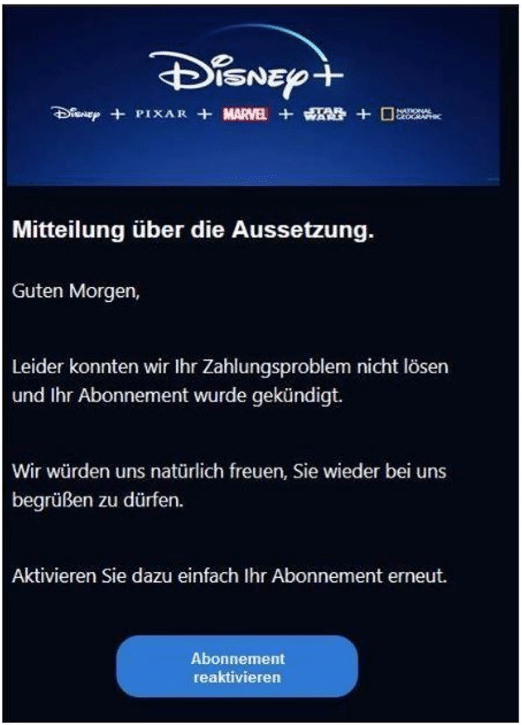The Internet has fundamentally changed the way we communicate, shop and work. Streaming on Disney+ is also included. But as the possibilities grow, so do the risks. Fraudsters are using the anonymity and reach of digital platforms to use increasingly sophisticated methods to obtain the money and sensitive data of unsuspecting consumers. A recent example that underscores the need for a vigilant online presence is a phishing email aimed specifically at customers of the Disney+ streaming service. This scam is part of a larger wave of fraud aimed at deceiving and harming consumers through digital channels.

The scam: False threats of termination from Disney+
Fraudulent emails claiming that a user's subscription has been canceled due to an unresolved payment issue (in our case, Disney+) are a common way to incite panic and provoke hasty reactions. The message asks the recipient to reactivate their subscription by clicking a button, which gives fraudsters access to credit card details and personal information. This technique plays on users' fear of losing an important service and exploits their spontaneous reaction to invade their privacy.
Protective measures and awareness raising
To protect yourself from such scams, it is important to develop a critical awareness of the signs of phishing attacks. Consumer advocates advise never to click on links or buttons in suspicious emails and to move such messages directly to the spam folder. In addition, it makes sense to regularly check the official channels of the service providers and, if in doubt, to ask directly via verified contact channels.
Supplementary measures
In addition to individual precautionary measures, technical solutions such as spam filters, regular security updates and the use of two-factor authentication can offer additional protection. Education and awareness-raising also play an important role. Publicizing and discussing current scams in the media and by consumer advocacy organizations can help create broader awareness and protect potential victims from harm.
Questions and answers about protecting yourself from online fraud:
Question 1: How do I recognize phishing emails?
Answer 1: Look out for impersonal salutations, spelling mistakes, unusual requests and check the sender address for inconsistencies.
Question 2: What should I do if I receive a suspicious email?
Answer 2: Do not click on any links or buttons and move the email to the spam folder. If in doubt, contact the service provider directly through official channels.
Question 3: How can I additionally protect myself?
Answer 3: Use technical protection measures such as spam filters and two-factor authentication and stay up to date on current scams.
Question 4: Are only large companies like Disney+ the target of such attacks?
Answer 4: No, scammers target a variety of services, from financial services to social media, to obtain personal information.
Question 5: How can I help others protect themselves?
Answer 5: Inform friends and family about the dangers and share information about known scam methods.
Conclusion
Digitalization has opened many doors, but also brought with it risks such as online fraud and phishing. The recent scams targeting Disney+ customers are a cautionary tale about the importance of staying vigilant and informed. By recognizing the signs, acting carefully and educating ourselves and those around us, we can stay one step ahead. In addition to individual measures, it is important to raise awareness of such threats and to ensure comprehensive protection through education and technical solutions.
Subscribe to the Mimikama newsletter at https://www.mimikama.org/mimikama-newsletter/ and attend our online lectures and workshops at https://www.mimikama.education/online-vortrag-von-mimikama/, to stay informed and deepen your knowledge of online security.
Source: t-online.de
You might also be interested in:
Notes:
1) This content reflects the current state of affairs at the time of publication. The reproduction of individual images, screenshots, embeds or video sequences serves to discuss the topic. 2) Individual contributions were created through the use of machine assistance and were carefully checked by the Mimikama editorial team before publication. ( Reason )

